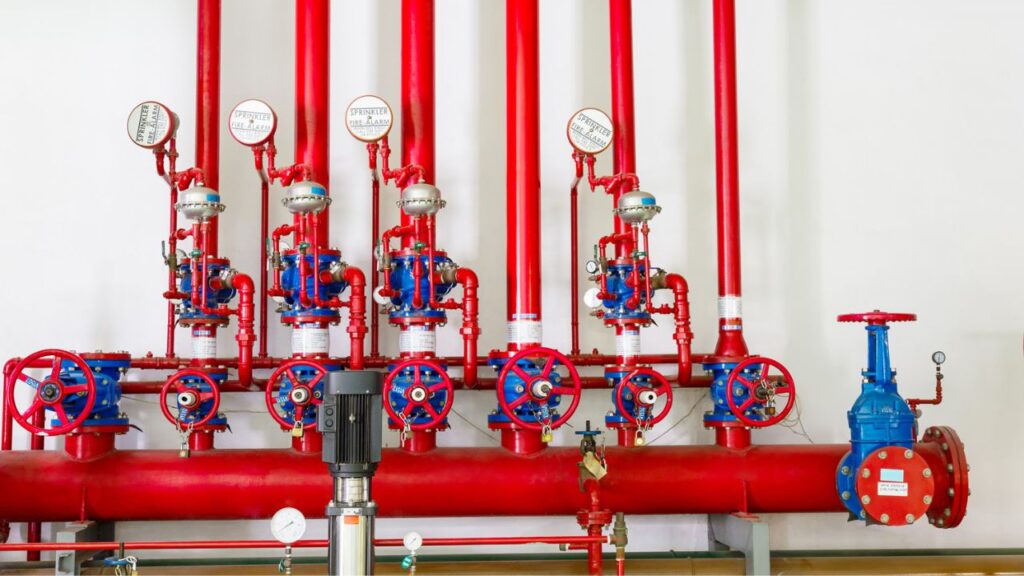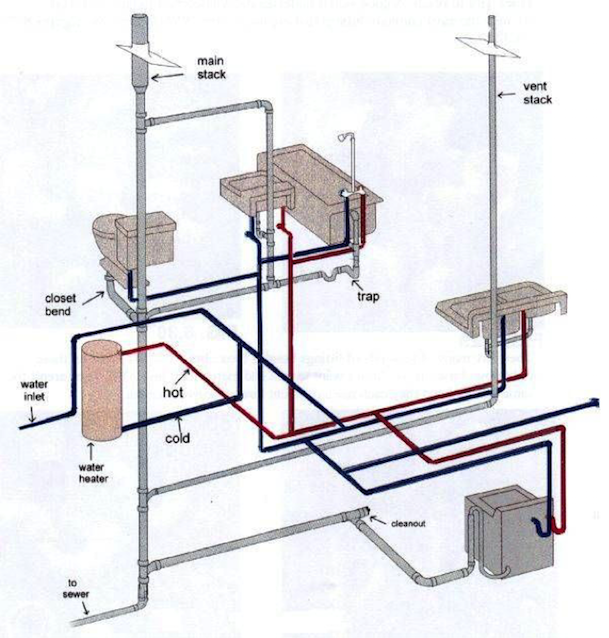Nearly everybody is bound to have their private idea about Anatomy of a House: Understanding the Components.

Recognizing how your home's plumbing system functions is vital for every single home owner. From delivering tidy water for drinking, food preparation, and bathing to safely getting rid of wastewater, a well-kept pipes system is important for your family members's health and convenience. In this comprehensive guide, we'll explore the complex network that makes up your home's plumbing and deal suggestions on upkeep, upgrades, and handling usual problems.
Intro
Your home's plumbing system is greater than just a network of pipes; it's an intricate system that ensures you have access to tidy water and reliable wastewater removal. Understanding its parts and how they collaborate can aid you avoid costly repair services and ensure whatever runs smoothly.
Fundamental Elements of a Plumbing System
Pipes and Tubes
At the heart of your pipes system are the pipes and tubes that carry water throughout your home. These can be made from numerous materials such as copper, PVC, or PEX, each with its advantages in regards to sturdiness and cost-effectiveness.
Components: Sinks, Toilets, Showers, etc.
Fixtures like sinks, bathrooms, showers, and bath tubs are where water is made use of in your house. Recognizing how these fixtures link to the plumbing system aids in diagnosing problems and preparing upgrades.
Valves and Shut-off Factors
Shutoffs regulate the circulation of water in your pipes system. Shut-off valves are critical throughout emergencies or when you require to make fixings, permitting you to separate parts of the system without disrupting water flow to the entire home.
Water System
Key Water Line
The major water line links your home to the community water system or a private well. It's where water enters your home and is distributed to various components.
Water Meter and Stress Regulatory Authority
The water meter measures your water use, while a pressure regulator guarantees that water flows at a safe stress throughout your home's pipes system, protecting against damages to pipelines and components.
Cold Water vs. Hot Water Lines
Recognizing the difference between cold water lines, which supply water directly from the primary, and hot water lines, which carry heated water from the water heater, aids in repairing and preparing for upgrades.
Water drainage System
Drain Pipeline and Traps
Drain pipes lug wastewater away from sinks, showers, and commodes to the sewage system or septic system. Traps prevent sewer gases from entering your home and additionally catch debris that could create obstructions.
Air flow Pipelines
Ventilation pipes permit air right into the water drainage system, stopping suction that might reduce drain and cause catches to vacant. Appropriate ventilation is vital for maintaining the honesty of your pipes system.
Significance of Correct Drain
Guaranteeing correct drain prevents back-ups and water damages. Frequently cleaning up drains and maintaining catches can avoid pricey repair services and extend the life of your pipes system.
Water Heating Unit
Types of Hot Water Heater
Water heaters can be tankless or standard tank-style. Tankless heaters warm water on demand, while containers store warmed water for immediate usage.
How Water Heaters Attach to the Plumbing System
Understanding exactly how water heaters attach to both the cold water supply and warm water circulation lines helps in identifying problems like not enough hot water or leaks.
Maintenance Tips for Water Heaters
Frequently purging your water heater to get rid of sediment, checking the temperature level setups, and checking for leaks can prolong its lifespan and enhance energy efficiency.
Typical Plumbing Problems
Leakages and Their Reasons
Leaks can take place due to maturing pipelines, loose installations, or high water pressure. Dealing with leakages promptly avoids water damages and mold development.
Clogs and Blockages
Obstructions in drains pipes and toilets are commonly brought on by flushing non-flushable things or an accumulation of oil and hair. Making use of drainpipe screens and bearing in mind what goes down your drains can avoid blockages.
Indicators of Pipes Problems to Watch For
Low water pressure, slow-moving drains pipes, foul odors, or unusually high water bills are signs of possible pipes troubles that need to be dealt with quickly.
Pipes Upkeep Tips
Regular Assessments and Checks
Arrange yearly pipes inspections to catch problems early. Try to find indicators of leaks, rust, or mineral accumulation in taps and showerheads.
Do It Yourself Upkeep Tasks
Simple tasks like cleaning faucet aerators, checking for toilet leaks using dye tablets, or protecting subjected pipelines in cool climates can avoid significant plumbing issues.
When to Call an Expert Plumbing Technician
Know when a pipes concern calls for specialist expertise. Trying intricate repair services without appropriate knowledge can lead to even more damage and higher repair service costs.
Upgrading Your Pipes System
Reasons for Upgrading
Updating to water-efficient components or replacing old pipelines can improve water top quality, minimize water expenses, and enhance the value of your home.
Modern Pipes Technologies and Their Advantages
Check out innovations like wise leak detectors, water-saving toilets, and energy-efficient hot water heater that can conserve money and lower ecological effect.
Cost Factors To Consider and ROI
Calculate the ahead of time expenses versus long-term savings when taking into consideration plumbing upgrades. Several upgrades spend for themselves with reduced energy expenses and fewer fixings.
Environmental Effect and Preservation
Water-Saving Fixtures and Devices
Installing low-flow taps, showerheads, and bathrooms can significantly reduce water use without sacrificing performance.
Tips for Minimizing Water Usage
Straightforward practices like taking care of leaks without delay, taking shorter showers, and running complete lots of laundry and recipes can save water and reduced your utility bills.
Eco-Friendly Pipes Options
Consider lasting pipes products like bamboo for flooring, which is durable and green, or recycled glass for counter tops.
Emergency situation Preparedness
Actions to Take Throughout a Pipes Emergency
Know where your shut-off shutoffs are located and just how to switch off the supply of water in case of a ruptured pipe or major leakage.
Significance of Having Emergency Calls Useful
Keep call information for neighborhood plumbing professionals or emergency services easily offered for quick reaction throughout a plumbing dilemma.
Do It Yourself Emergency Fixes (When Suitable).
Temporary fixes like using air duct tape to spot a leaking pipe or putting a container under a leaking tap can minimize damage up until a specialist plumber shows up.
Conclusion.
Comprehending the makeup of your home's plumbing system encourages you to keep it effectively, saving money and time on fixings. By following regular upkeep routines and remaining informed about contemporary plumbing modern technologies, you can ensure your plumbing system operates effectively for several years ahead.
HOW YOUR PLUMBING SYSTEM WORKS
Which Pipes Do What?
Blue lines = fresh water supply entering the building
Red lines = hot water supply entering the building
Grey lines = pipes carrying waste away from the building and venting pipes carrying gases away from the building (through the roof)
YOUR MAIN PLUMBING SYSTEMS
There are two main plumbing systems that support your home s basic plumbing needs one that brings clean water into your home, and one that sends dirty water away from your home. Connected to the toilet, bath, shower, and other faucets in your home, these two systems keep your water flowing in the right directions.
ACCESSING FRESH WATER
Fresh and clean water is brought into your home through the main water supply line . Filtered through one pipe, this water is pressured to flow into the various fixtures in your home at any given time.
This water can be sourced from a well located on your property, a pond or river (mostly cottages), or, as in most cases, from the city s municipal water treatment centre. However, it is important to note that water that is untreated, such as the water siphoned from ponds or rivers, may not be safe to drink. Personal water supplies always need to be treated for hardness and contaminants before consumed.
MUNICIPAL WATER SUPPLIES
Improve taste and odour
Remove sediment
Eliminate hardness
Reduce chlorine
COLD WATER SUPPLY VS. HOT WATER SUPPLY
Cold water flows into your home or building through the service line, which then distributes hot or cold water to your fixtures. This line is most commonly run through a central column that runs floor to floor. Hot water runs in short and straight pipes as the longer the pipeline, the more heat that will be lost in the transfer. Having shorter pipes also allows residents to access hot water more quickly.
WASTE WATER SYSTEM
Your wastewater system is divided into two parts pipes that send wastewater away from your home and venting pipes that send sewer gas away from your home. Sewage water travels through pipes that flush the water and waste towards local sewers that are operated and managed by your city or town. Most sewer systems rely on gravity to move the wastewater to where it needs to go.
The further away from your toilet or sink, the larger wastewater pipes become. This allows for waste to be disposed of from various parts of your home or business at once without pipe blockages. The angle and flow of these pipes are also essential for keeping your waste pipes clear of build up.
https://harrisplumbing.ca/how-your-home-plumbing-system-works/

HOW YOUR PLUMBING SYSTEM WORKS
Which Pipes Do What?
YOUR MAIN PLUMBING SYSTEMS
There are two main plumbing systems that support your home s basic plumbing needs one that brings clean water into your home, and one that sends dirty water away from your home. Connected to the toilet, bath, shower, and other faucets in your home, these two systems keep your water flowing in the right directions.
ACCESSING FRESH WATER
Fresh and clean water is brought into your home through the main water supply line . Filtered through one pipe, this water is pressured to flow into the various fixtures in your home at any given time.
This water can be sourced from a well located on your property, a pond or river (mostly cottages), or, as in most cases, from the city s municipal water treatment centre. However, it is important to note that water that is untreated, such as the water siphoned from ponds or rivers, may not be safe to drink. Personal water supplies always need to be treated for hardness and contaminants before consumed.
MUNICIPAL WATER SUPPLIES
COLD WATER SUPPLY VS. HOT WATER SUPPLY
Cold water flows into your home or building through the service line, which then distributes hot or cold water to your fixtures. This line is most commonly run through a central column that runs floor to floor. Hot water runs in short and straight pipes as the longer the pipeline, the more heat that will be lost in the transfer. Having shorter pipes also allows residents to access hot water more quickly.
WASTE WATER SYSTEM
Your wastewater system is divided into two parts pipes that send wastewater away from your home and venting pipes that send sewer gas away from your home. Sewage water travels through pipes that flush the water and waste towards local sewers that are operated and managed by your city or town. Most sewer systems rely on gravity to move the wastewater to where it needs to go.
The further away from your toilet or sink, the larger wastewater pipes become. This allows for waste to be disposed of from various parts of your home or business at once without pipe blockages. The angle and flow of these pipes are also essential for keeping your waste pipes clear of build up.
https://harrisplumbing.ca/how-your-home-plumbing-system-works/
Hopefully you enjoyed reading our excerpt on . Many thanks for taking a few minutes to browse our article. Remember to set aside a second to share this write-up if you enjoyed reading it. Thank you for your time invested reading it.
Book A Service